- ABOUT US
- PROGRAM AREAS
- CONSERVATION APPROACH
- EDUCATION
- MULTIMEDIA
2022 Featured Stories
December
How can we make coral cover data more accessible and usable?

Coral reefs are threatened due to a lot of factors including climate change, unsustainable fishing practices, and land-based sources of pollution. In order for decision and policy makers to really understand the status and trends of coral reef ecosystems, we need the data to be accessible to data analysts and in the same format so it can be compared to other datasets. That way, we can do analyses that help us really understand coral health so we can make science-based management decisions.
Coral Reef Task Force Graduates First Watershed from Watershed Partnership Initiative
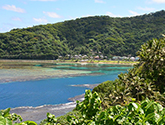
Addressing excess land-based sources of pollution is an important management action for improving water quality to support resilient coral reef ecosystems. The U.S. Coral Reef Task Force developed the Watershed Partnership Initiative to facilitate interdisciplinary partnerships with federal, state/territory, and local entities to mitigate pollution from priority watersheds adjacent to valuable coral reef resources. In 2012, Faga'alu watershed in American Samoa was selected as a priority site for the Initiative, and in 2022, was honored as its first graduate.
November
National Coral Reef Monitoring Program report summarizes latest status and trends for Florida's Coral Reef
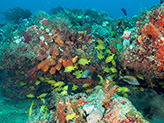
A report released in October 2022 describes the status and trends of Florida's coral reef ecosystem using data from the National Coral Reef Monitoring Program (NCRMP).
October
Adventures of the U.S. Coral Reef Task Force in Hawai'i
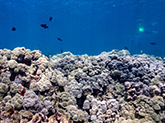
Recently, The US Coral Reef Task Force hosted its first in-person meeting since 2019 in Kona, Hawai'i. The week was filled to the brim with educational and inspired conversations around coral reef conservation. Participants had the opportunity to explore efforts to protect coral reefs in beautiful Hawai'i on site visits that were organized by the local planning team. On the island of Hawai'i, these locations included the Kaloko-Honokōhau National Historical Park, Miloli'i Community-Based Subsistence Fishing Area, the South Kohala Watershed, and Kealakekua Bay.
The Coral Program's 2022 Ernest F. Hollings Scholar: Madison Gard
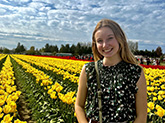
In June, the Coral Reef Conservation Program welcomed a new Ernest F. Hollings undergraduate intern, Madison Gard. Madison is a double-major at Western Washington University (Bellingham, WA) studying environmental science with a marine emphasis and Spanish. Her interest in fisheries and ecosystem-based management was sparked by her work in the Marine Mammal Ecology Lab at her university where she is a research assistant working on a variety of projects.
September
Release of NOAA's Implementation Plan for Stony Coral Tissue Loss Disease Response and Prevention

The implementation plan for NOAA's Stony Coral Tissue Loss Disease Response and Prevention Strategy provides key actions by NOAA and partners that will increase understanding of and response to the disease in the Atlantic and Caribbean region and prevent its spread to the Indo-Pacific. It presents a clear, specific plan of action that can be used to secure funding for key disease research, response, engagement, and prevention activities over the next five years (2022-2027).
July
Incredible recognition by world leaders on the imperative for coral conservation and recovery

The 2022 UN Ocean Conference in Lisbon, Portugal was a huge success for coral reef ecosystems. Global leaders from nations, industry, and non-governmental organizations came together to highlight and commit to coral conservation and recovery.
June
Capitol Hill Ocean Week 2022: Sea the Future

Capitol Hill Ocean Week (CHOW) 2022 was special because it was the first in-person meeting since the start of the pandemic, and it was also a celebration of the past 50 years of marine and freshwater conservation. And, over the past 50 years, our oceans have felt the effects from numerous environmental pressures such as climate change and marine debris. Organized by The National Marine Sanctuary Foundation, Capitol Hill Ocean Week gave managers, scientists, policymakers, and ocean advocates a space to brainstorm innovative solutions that will float us into a better, brighter future. The Coral Reef Conservation Program's (the Coral Program's) Caroline Donovan (Communications Director) and Madyson Miller (Knauss Fellow) attended CHOW 2022 in-person and are feeling optimistic about the future of U.S. coral reefs and oceans.
Release of the Fiscal Years (FY) 2020-2021 Implementation of the Coral Reef Conservation Program Report

CRCP released the Fiscal Years (FY) 2020-2021 Implementation of the Coral Reef Conservation Program Report, which covers coral reef ecosystem-related research and management activities conducted during FY 2020-21 and reflects the goals and objectives of the Coral Program Strategic Plan. The Coral Program continued to adapt and respond to emerging issues, such as coral disease mitigation and restoration techniques.
Read the full report for more details.
Global SocMon: The Critical Role of Socioeconomic Data in Coral Reef Monitoring
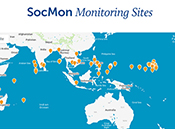
Socioeconomic monitoring is important to track how people use and depend on coral reefs, and to understand human impacts to coral ecosystems so that we can mitigate negative effects while promoting positive benefits. To have effective coral reef conservation, we need an informed and engaged public, and socioeconomic monitoring is a way to bring in the human dimension of coral reef conservation.
May
The Global Coral Reef Monitoring Network- Charting a Course Toward Data Interoperability

In March 2022, the GCRMN Steering Committee* met in the Principality of Monaco as part of Monaco Ocean Week from March 22-24. Over 20 people participated in person and 11 people participated virtually. The countries of Australia, Monaco, France, the United States, the United Kingdom, the United Arab Emirates, Sri Lanka, Switzerland, Kenya, Ecuador, the Maldives, Palau, and more were represented at the meeting.
How Can the National Coral Reef Monitoring Program Help Understand Long-Spined Sea Urchin Die-Offs?

The Caribbean may be facing a widespread die-off of sea urchins. Diadema antillarum, also known as the long-spined sea urchin, is one of the most important herbivores on Caribbean coral reefs because they eat algae, reducing algal overgrowth on the seafloor, which in turn provides reef area for coral growth. Diadema antillarum previously experienced a massive die-off throughout the Caribbean in the 1980s. In February 2022, scientists learned of extensive Diadema antillarum die-offs in St. Thomas, U.S. Virgin Islands (USVI).
Independent Survey Data Improves Management of Caribbean Queen Triggerfish

Queen triggerfish is a Caribbean reef fish that is harvested by local fishermen and sold to restaurants and fish markets throughout the islands. Due to this demand and its importance to coral reef ecosystems, this fishery is managed in the U.S. Exclusive Economic Zone (EEZ) through a Fishery Management Council as established through the Magnuson-Stevens Fishery Conservation and Management Act.
April
Madyson Miller: The Coral Program's 2022 Knauss Fellow

In February, we welcomed our 2022 Knass fellow, Madyson Miller. Madyson was sponsored by Puerto Rico Sea Grant and holds a master's degree in marine and environmental science from the University of the Virgin Islands (UVI).
About Us

The NOAA Coral Reef Conservation Program was established in 2000 by the Coral Reef Conservation Act. Headquartered in Silver Spring, Maryland, the program is part of NOAA's Office for Coastal Management.

The Coral Reef Information System (CoRIS) is the program's information portal that provides access to NOAA coral reef data and products.
Work With US
U.S. Coral Reef Task Force
Funding Opportunities
Employment
Fellowship Program
Contracting Assistance
Graphic Identifier
Featured Stories Archive

Access the archive of featured stories here...
Feedback
Thank you for visiting NOAA’s Coral Reef Conservation Program online. Please take our website satisfaction survey. We welcome your ideas, comments, and feedback. Questions? Email coralreef@noaa.gov.
Stay Connected
Contact Us
NOAA’s Coral Reef Conservation Program
SSMC4, 10th Floor
1305 East West Highway
Silver Spring, MD 20910
coralreef@noaa.gov
